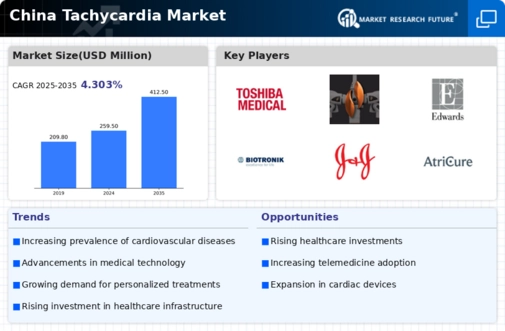The China Tachycardia Market has become a focal point for various healthcare players due to the rising prevalence of tachycardia and related cardiovascular conditions among the population. This market is characterized by intense competition driven by technological advancements, increasing consumer awareness, and the growing healthcare infrastructure. Several domestic and international companies are vying for market share, making it essential to assess their competitive strengths, product innovations, and market strategies.
The competitive landscape is marked by significant investments in research and development aimed at introducing advanced treatment options, along with strategic collaborations that enable companies to expand their reach and enhance their market presence effectively.Medtronic has established a stronghold in the China Tachycardia Market by leveraging its advanced technology and extensive product portfolio. The company focuses on innovative therapies and devices for arrhythmia, which has contributed to its reputation as a leader in cardiac treatment solutions.
Medtronic's strengths in this market include a well-established distribution network, rigorous regulatory compliance, and substantial investment in local research to better understand the needs specific to the Chinese population.
Their ability to integrate feedback into product design allows them to tailor solutions that resonate well with healthcare providers and patients alike, ensuring they remain a principal player in the highly competitive landscape of cardiac care.Toshiba Medical Systems also plays a crucial role in the China Tachycardia Market, recognized for its diagnostic imaging systems and advanced cardiovascular solutions. The company's strengths lie in its innovative technologies and ability to deliver high-quality imaging services that aid in precise cardiac assessments, which are crucial for effective tachycardia management.
Toshiba Medical Systems has a notable market presence through collaborations with hospitals and healthcare institutions across China, boosting their visibility and accessibility.
The company has also made strategic moves, including mergers and acquisitions, which have enhanced its capabilities and expanded its portfolio of services in the cardiovascular domain. By consistently upgrading its technology and maintaining strong relationships with local healthcare providers, Toshiba Medical Systems continues to solidify its position in a market that is becoming increasingly competitive and demanding.





















Leave a Comment